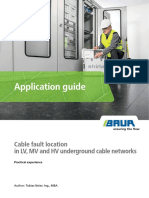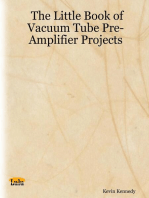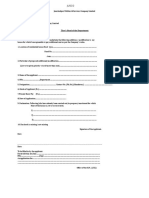Economics Basis
Economics Basis
Uploaded by
kumarCopyright:
Available Formats
Economics Basis
Economics Basis
Uploaded by
kumarOriginal Description:
Original Title
Copyright
Available Formats
Share this document
Did you find this document useful?
Is this content inappropriate?
Copyright:
Available Formats
Economics Basis
Economics Basis
Uploaded by
kumarCopyright:
Available Formats
5 Repairing of Cable
Joints
INTRODUCTION
Electrical joints and terminations provide the required
electrical connection as well as the mechanical support
and physical protection to the cable. It is important
for the Cable jointing system to suit the service and
operational requirements for all industrial cable
jointing environments and applications. These devices
are important for jointing the cables and wires. A
good cable jointing and installation provides a better
supply of power (Fig. 5.1). Cable
jointing has become the preferred pick
over conventional systems for cable
termination, cable abandonment, low
voltage cable jointing and cable repair.
The cable termination and jointing
kits are often specialised in wire
installations worldwide.
Cables play a very important role in
the distribution system of power. There
are different types of cables like LT
cable, 11 KV cable and 33 KV cable.
Fig. 5.1 Electrical joint and terminations
Cables are used in places where bare
conductor cannot be used due to narrow roads. Cables
are costlier than the conductor and the same cannot be
replaced often.
Unit 5.indd 80 11-06-2019 12:41:58
SESSION 1: ELECTRICAL CABLE JOINTING
METHODS
Jointing of power cables should be as simple as twisting
and taping the wire. For jointing of a cable variety of
in-line adapters and connectors are used. The method
used for a cable joint depends on the voltage, type of
cable, type of joint, type of connector, application and
other factors. Proper tools and equipment are to be used
for jointing the cable.
Given below are some important factors to ensure
reliable connections, such as
� proper size of connectors should be used for a
particular cable,
� proper tools and equipment are to be used,
� cuts and stripping should be very clean,
� proper technique is to be used for cable jointing
and
� restoring the insulation, outer-sheath
and armour.
Western Union Splice Joint
The cables are manufactured for a particular length. To
increase the length of a cable a straight joint is used for
small solid cables (Figs. 5.2 and 5.3).
1. Remove the insulation of cable
2. Bring the two conductors to a crossed position
and then make a long bend or twist in each wire.
3. Wrap the end of one of the wires around the Fig 5.2 Western union splice and
straight joints
straight portion of the other wire, and then do
the same for the other wire. Repeat this for about
four or five times. bare wires twisted
wires
4. Press ends of the wires down close to the straight
portions of the wire to prevent the ends from
piercing through the insulation tape.
5. Insulate the joint using the insulation tape
Fixture Joint Fig. 5.3 Rattail joints
This is a type of branch joint connecting a thin wire (for
branch line) to the thick wire (main line), such as those
used in lighting fixtures.
REPAIRING OF CABLE JOINTS
81
Unit 5.indd 81 11-06-2019 12:41:59
1. Remove the insulation of wire
2. Wrap the fixture wire around the branch wire
3. Bend the branch wire over the
completed turns
4. Wrap the remaining fixture wire over the bent
branch wire
5. This can be followed by soldering and taping, or
Fig. 5.4 Fixture joint simply taping of the joint (Fig. 5.4).
Knotted Tap Joint
The knotted tap joint is also used for branch joints
to connect a branch wire (thin wire) to a continuous
or main wire (thick wire) (Fig. 5.5).
1. Remove about 1 inch of insulation from the
main wire and about 3 inches from the branch
Fig. 5.5 Knotted tap joint wire.
2. Place the branch wire behind the main wire so
that three-fourths of its bare wire extends above
the main wire.
3. Bring the branch wire over the main wire, around
itself, and finally over the main wire so that it
forms a knot. Wrap the wire around the main
conductor in short, tight turns and trim the end
Joints Using Wire Nut and Split Bolt
The rattail joint is replaced by wire nut. The nut is
usually housed in a plastic insulating casing. To make
a joint.
1. Strip the conductors
2. Place the two joints to be joined into the wire nut
3. Twist the nut
Split Bolt Connector
The split bolt is used to join big sized conductors. This
replaces the knotted tap joint and can be used to join
three ends or join a branch conductor to a continuous
(main) conductor (see Fig. 5.6).
The bare wires are placed through the space between
the two bolts, after which the nut is tightened to ensure
CABLE JOINTER — ELECTRICAL POWER SYSTEM — CLASS XI
82
Unit 5.indd 82 11-06-2019 12:41:59
a sound joint. The material required for making straight
or branch joints for steel wired armour cables are as
follows:
y Connectors
y Copper mesh tape
y Constant force springs for holding the wire
armour and copper mesh tape
y Standard PVC/Vinyl tape, which provides a Fig. 5.6 Split bolt
mechanical barrier between the over sheath layer
and the armour layer.
Preparing the Cable
Preparing the cable before jointing includes the
following steps (Fig. 5.7):
1. Remove the over sheath and the wire armour
2. Separate the wire armour and bend the wires
away from the cable, place the support ring under
the armour at each side of the joint
3. Cut back the cable insulation
4. Remove the insulation from each of the conductors
A+A
B A
Oversteam
Side A
Wire armour
A less B
Cut Back Side B
C Insulation
D
D
D
Support ring
E+E
Fig. 5.7 Preparation of a three-core armoured cable
Crimping and Insulating Each Cable
Once the cable is ready, connect each end of the
three conductors to a suitable connector (copper or
REPAIRING OF CABLE JOINTS
83
Unit 5.indd 83 11-06-2019 12:42:01
aluminium). Suitable-sized connectors are to be
used. Tightly fix the suitable connectors and test the
connection.
Tape the crimped connectors, wrap around and
extend to cover at least 25mm of the cable insulation of
the conductor entering the connectors (Fig. 5.8).
Fig. 5.8 Taped, crimped connectors on individual cables
Binding the Cables
Bind the wires tightly and then tape them together (Fig. 5.9).
Fig. 5.9 Wires taped together Restoring Armour and Applying Mesh Tape
1. Tightly wrap the cable from armour to armour
while applying adequate tension around the
insulation.
2. Join the wire armour from one end to the other
end and cut excess wire to the correct length.
Ensure the armour spreads evenly over the entire
joint.
3. Wrap the cable with the mesh tape and then use
the standard vinyl/PVC tape to wrap over the
mesh to provide a insulation against
stray wire ends. For the branch joint,
bring both the main and branch cables
together before wrapping.
Next, use standard vinyl or PVC tape
Fig. 5.10 Wrapping the cable with mesh tape to wrap over the constant force springs
placed over the under-armour rings. The
tape provides a barrier against sharp edges (Fig. 5.10).
Re-establish the Over Sheath
1. Use a self fusing tape to wrap over the cable and
establish the outer sheath. Start in the center
and apply one layer of tape to one end, wrapping
CABLE JOINTER — ELECTRICAL POWER SYSTEM — CLASS XI
84
Unit 5.indd 84 11-06-2019 12:42:02
over the jacket for at least 25 mm. Apply the tape
from the end towards the center so that you have
two layers on each side.
2. For branch joints, wrap over the insulation for
both the main and the branch cable, by at least
50mm. Bring the two together and fill it in with
the insulating putty from both sides. Do this up
to 25 mm away from the place where the branch
and the main cables are joined.
3. Put the two cables together and bind the main
and branch tightly over the filling. Finally, wrap
the crotch while pulling the branch away from the
main cable (Fig. 5.11).
Fig. 5.11 Restoring the over sheath on a branch joint
Electrical Power Cable Terminations Crimped
The electrical cable termination is a cable end that connector
plug
connects to the terminal of the equipment or another
cable to extend the length (Fig. 5.12). core insulation
The method used for termination of the cables varies
according to the type of cable, type of connector and cable gland
application. Some common types of terminations are
y crimp connection cable plate
y soldered connection
y compression termination Fig. 5.12 Low voltage cable
y wire-wrapping connection termination
y direct connection
y loop or eye connection
REPAIRING OF CABLE JOINTS
85
Unit 5.indd 85 11-06-2019 12:42:03
Some of the factors which are considered for
termination of cables are:
y Outdoor or indoor cable
y Voltage of the line
y Overhead or underground cable
y Type of connector on the equipment where the
cable will be connected
Cable Joints
A power cable consists of two or more electrical
conductors, held together wrapped with insulation and
outer surface with an overall sheath (Fig. 5.13).
The cables are used for transmission of electrical
power. Power cables is being used for permanent
wiring within buildings. The cable can be run under
ground, run overhead, or exposed. Cables consist
of three major components: conductors, insulation
Fig. 5.13 Cable joint and protective jacket. The structure of individual
cables varies according to application. Power cables use
stranded copper or aluminium conductors, although in
some cases solid conductors is used.
After the introduction of electric cables in electrical
circuit the problem of how to join them together arises
in order to achieve the degree of insulation, tensile and
crushing strengths, conductivity and accessibility. To
cope up the requirements a junction box is introduced.
The junction box typically incorporates:
y a method of securing the cable conductors
(usually by soldering, screw-clamps or
compressed ferrules).
y a method of insulation, which may be air,
oil, bitumen or insulation applied in the form
of tapes.
y a method of enclosure and protection applicable
to the environment.
As per The Electricity Regulations every joint and
connection should be mechanically and electrically
suitable for its use. In this respect the joint or connection
should be of proper construction as regards conductivity,
insulation, mechanical strength and protection.
Joints in Non-flexible Cables
Underground cables are joined by ferrules or lugs
(crimped) and the outer protection enclosure or box is
CABLE JOINTER — ELECTRICAL POWER SYSTEM — CLASS XI
86
Unit 5.indd 86 11-06-2019 12:42:03
usually filled with a plastic or bituminous compound.
Such joints are often used above-ground for non-flexible
cables and are adequately protected and supported.
Other cables which are fixed wiring installations enclosed
junction boxes are used to making a joint between two
cables. These junction boxes are not securing the cable
against strain.
Joints in Flexible Cables
Joints in flexible cables are not usually satisfactory
because:
1. stranded conductors are not suitable for certain
methods of jointing.
2. mechanical tensile strength and resistance are
difficult to maintain.
3. fatigue damage may occur when rigid joint is
being done.
Some joints and cable connectors are much more
acceptable these incorporate terminals or compression
fittings suitable for stranded conductors. Cable
clamps are used for plugs to reduce the flexing.
Heat-shrinkable or pre-stretched sleeving may be
adequate in some cases but other circumstances may
demand additional protection.
Types of Cable Joints and Equipment
A great majority of failure in cable network is associated
with faulty cable jointing. It is, therefore, essential to
use proper jointing technique, good quality insulating
material and standard accessories for cable jointing.
Cable joints are of three types:
Straight through Joint
Straight through Joints are an important part of today’s
power cable networks (Fig. 5.14). These joints offer
reliability and flexibility to meet the demands of cable
network.
Straight through Joints provide
y quick cable preparation
Fig. 5.14 Single Core Straight
y high electrical insulation through Joint Kits
y no moisture ingress
REPAIRING OF CABLE JOINTS
87
Unit 5.indd 87 11-06-2019 12:42:04
y good mechanical strength
Semi-conductive tape y compact dimensions and is suitable
Waterproof seal gum
Semi-conductive tubing
for all conductor, shape and material
Outer insulation tubing
Cable insulation layer
Inner insulation tubing Straight through Joints are made by
Connector tubing
Semi-conductive metal joining processes, such as welding
Stress control tubing and soldering (Fig. 5.15).
Semi-conductive tubing
Copper screen T-Joint
Fig. 5.15 Straight through Joint These types of joints are used for branching
of a service cable from a main cable.
T-joints are helpful as turning and twisting of cable
damages its outer core (Fig. 5.16).
Terminal Joint
These type of joints connect cable to switch gear,
transformer terminal or to an overhead line (Fig. 5.17).
Fig. 5.16 T-Joint
Conductor Joint
The length of distribution lines are in kilometers and one
coil of conductor is unable to solve the length problem.
Hence, jointing the conductor is necessary.
Britannia Joint
This type of joint is made only on solid conductors
and cannot be made on stranded conductor. Two
Fig. 5.17 Terminal Joint conductors to be joined are brought in front of each
other of about 6 inch (150 mm) of length. Both the
conductors should be clean. If the conductor is of
copper; it should make good electrical connection.
Then ends of both conductors are bent through
half centimetre and placed on each other.
The length of contact portion should be min.
100 mm. This joint should be bound by 14 mm copper
wire as shown in Fig. 5.18.
Fig. 5.18 Britannia Joint Telephone Joint (Western Union)
This joint is used only for solid conductors. It is used
for conductors of size 8 SWG or higher size. First,
bend is given at 100 to 125 mm from the edge and are
placed over each other. Then each one is twisted with
another conductor.
CABLE JOINTER — ELECTRICAL POWER SYSTEM — CLASS XI
88
Unit 5.indd 88 11-06-2019 12:42:05
Married Joints
This joint is made between copper conductors having
central strand of GI wire (Fig. 5.19). It should not be made
between aluminium (Al) conductors. Approximately 175
to 200 mm length conductor strands are unwound. The
GI strand of both conductors should be broken up to
175 mm in length. Both conductors should be brought
in front of each other and their strands should be woven
in each other. The strand of one conductor is twisted
on other conductor, and strand of other conductor is
twisted on the first. Likewise all the strands twisted and
then soldered. This is used only for small span length.
Before Jointing
Preparation of ‘T’ Joint
After Jointing ‘T’ Joint After Completion
Fig.5.19 Married Joint Fig. 5.20 ‘T’ Joint
Sleeve Joint
It can be made with any type of aluminium
conductor. Graphite Greece is applied over the
Fig. 5.21 Sleeve Joint
conductor and as shown in Figs. 5.20 and 5.21
sleeves should be taken. These sleeves should be
placed on the conductor as shown. Sleeves should be
twisted by twisting wrench. This joint is made for LT,
HT, ACSR, AAC conductor up to 0.06 cm2.
Compression Joint
This joint is used for conductors of more than
0.06 cm2 sizes. For jointing, two different sleeves are
used. Steel sleeve is used for steel conductor strands
and aluminium. sleeve is used for Al. conductor strands.
There are two holes in Al. sleeve. Rebating is done
REPAIRING OF CABLE JOINTS
89
Unit 5.indd 89 11-06-2019 12:42:05
through these holes. Then Al. sleeve to be mounted on
one side. The length of steel sleeve is then measured.
Its half distance is taken. Suppose it is ‘X’ cm. Then
the ends which are to be joined and more to ‘X’ cm
distance is taken on the conductor is banded there.
The Al. strands are opened up to that point and cut.
Steel strand should not be touched during this. They
are placed in the steel sleeve. They should be kept in
front of each other. Then the center of steel sleeve is
compressed through compression machine. Then on
the half portion of the right side sleeve be compressed
and then on the left half portion. Due to compression
the length of sleeve will be increased by 6mm on both
sides and it will reach Al. strands. Then Al. sleeve
should be measured. It should be halved. Suppose it is
‘Y’ cm then ‘Y’ cm should be measured and marked on
both sides of conductor measured from center of steel
sleeve. Both parts of conductor are brought in sleeve
in front of each other. The filler parts should be filled
in the sleeve by Grease until it comes out of the holes.
Both the holes are then closed by rivets and hammered
by hammer. There is one stencil mark on Al. sleeve.
The first compression will be there; afterwards it will be
compressed up to one end. Similarly the other part is
compressed up to the other end.
Jumpering
Connecting two conductors or wires is called jumpering
(Fig. 5.22).
Jumper should not be connected to the main
conductor. The jumper should always be connected by
PG clamps.
When the jumpers are near metallic portion, all such
Fig. 5.22 Jumpering
jumpers are covered with alkathane pipe.
Conductor joints are marked on ACSR conductor
when dispatched. Mid-span joint should be made before
stringing as the steel strand is not kept continuous.
Hence, it is necessary to replace the company joint.
Care should be taken that mid-span joint is
not less than 40 ft. from pole. Every joint should be
done carefully.
Where conductor strands are cut, repair sleeve
is used. Conductor joint strength should be 95%
that of conductor, and resistance should be that of a
main conductor.
CABLE JOINTER — ELECTRICAL POWER SYSTEM — CLASS XI
90
Unit 5.indd 90 11-06-2019 12:42:06
HV Cable Jointers Tools
Using the correct cable tools to prepare industrial and
utility cables before cable jointing and terminating
reduces catastrophic cable failures. Some of the
important cable jointer tools include:
y Cable cutting tool
y Cable crimping tool (hydraulic, battery, ratchet)
copper/aluminium cables
y Cable spiking tools for LV-HV cables (cartridge/
hydraulic)
y Heat shrink gas torches for LV-HV jointing
y Screen scoring tools for bonded/easy peel
HV cables
y Outer sheath stripping tools, LV-HV cables
y Insulation (XLPE) stripping tools, HV cables
y Insulated tools for live-working
y Cable laying rollers, socks, jacks and pulling
equipment
y Conduit duct rods
Procedure for Heat Shrink Straight
through Joint
Mark reference line Park outer scaling sleeves Remove sheath
and armour
Adjust support
Adjust support ring Adjust support ring
ring
Secure SWA onto
support ring
Remove bedding
Mark reference
line
REPAIRING OF CABLE JOINTS
91
Unit 5.indd 91 11-06-2019 12:42:22
File screen cut
Remove copper tape shield
Cut cores at
reference line
Shrink stress control tubing
Remove insulation
Remove conductive layer
Apply filler putty
Park insulation tubing Apply stress control patch
Apply copper mesh shielding
Position insulation tubing
Position and secure armour case
Protect protruding edges
CABLE JOINTER — ELECTRICAL POWER SYSTEM — CLASS XI
92
Unit 5.indd 92 11-06-2019 12:42:29
Check Your Progress
A. Write short notes on
1. LT cables Joints
2. Straight through joint
3. Britannia Joint
4. T-joint
B. State whether the following statements are True or False
1. Western Union joint are used for all conductors.
2. Meried joint should not be made between
aluminium conductors.
3. Crimping is necessary for jointing the cable.
C. Short answer questions
1. List the steps used in preparing of the cable.
2. Explain the different types of joints.
3. Differentiate between fixture joint and western union
splice joint.
4. Explain the procedure for heat shrinking straight
through joint.
REPAIRING OF CABLE JOINTS
93
Unit 5.indd 93 11-06-2019 12:42:29
You might also like
- Automotive Wiring and Circuit DiagramsDocument36 pagesAutomotive Wiring and Circuit Diagramsngelectronic522676% (29)
- Underground Cable LayingDocument17 pagesUnderground Cable LayingManu JojoNo ratings yet
- Risk Assessment and Lightning Protection For PV Systems and Solar Power PlantsDocument4 pagesRisk Assessment and Lightning Protection For PV Systems and Solar Power PlantsArshia GhNo ratings yet
- " Staircase Wiring": A Project Report ONDocument17 pages" Staircase Wiring": A Project Report ONydfjgjdhjncNo ratings yet
- snla219Document10 pagessnla219Carlos Ruiz MoraNo ratings yet
- 01-ABEn154-Laboratory Information Sheet No. 1Document7 pages01-ABEn154-Laboratory Information Sheet No. 1Jacky Lou GermanoNo ratings yet
- CH-5 Optical Connectors PDFDocument31 pagesCH-5 Optical Connectors PDFNaser MahmudNo ratings yet
- Joe Carr's Radio Tech-Notes - Transmission LineDocument5 pagesJoe Carr's Radio Tech-Notes - Transmission LineBenjamin DoverNo ratings yet
- WEEK 5 - Electricity and Its Sources Building Utilities 2Document30 pagesWEEK 5 - Electricity and Its Sources Building Utilities 2jpdbautista2921No ratings yet
- Mcdowall 2009Document11 pagesMcdowall 2009holofaNo ratings yet
- TLE 10 EPAS Week3Document6 pagesTLE 10 EPAS Week3Sittie Fahieda Aloyodan100% (2)
- Practical Guide To Cable SelectionDocument12 pagesPractical Guide To Cable Selectionazitagg100% (1)
- Report On Fire SafetyDocument12 pagesReport On Fire SafetyRashmiGoyalNo ratings yet
- Learning Module - Joints, Taps and SplicesDocument9 pagesLearning Module - Joints, Taps and SplicesCarlo Cartagenas50% (2)
- Electronics 4Document29 pagesElectronics 4mahinayzachlouisNo ratings yet
- Digital CLASS BE YR 12 WK 7 2023Document18 pagesDigital CLASS BE YR 12 WK 7 2023collinsolukwuNo ratings yet
- css10 Week 5Document8 pagescss10 Week 5lesterNo ratings yet
- Electronic Project ProposalDocument35 pagesElectronic Project ProposalmahinayzachlouisNo ratings yet
- 7H0011X0 W&C Tech Handbook Sec 04Document5 pages7H0011X0 W&C Tech Handbook Sec 04Ferran MunyósNo ratings yet
- ContentsDocument7 pagesContentsTerdy MNNo ratings yet
- DT Fibre Optic Cable&Connector Guide White Paper Rev.1.0Document6 pagesDT Fibre Optic Cable&Connector Guide White Paper Rev.1.0DnetoNo ratings yet
- UNIT.5.Fiber Couplers and ConnectorsDocument52 pagesUNIT.5.Fiber Couplers and ConnectorsNandan GowdaNo ratings yet
- Hand-Out For CO LessonPlan Fabricate Ethernet CablesDocument4 pagesHand-Out For CO LessonPlan Fabricate Ethernet CablesFearNova QuasarNo ratings yet
- Types of CablesDocument12 pagesTypes of CablesBhupender Kumar MahurNo ratings yet
- SLM Css m6 EditedDocument3 pagesSLM Css m6 EditedJeannettee ParrochaNo ratings yet
- Electrical Service Power Station, AC-DC Current, Distribution Board and Wiring SystemDocument16 pagesElectrical Service Power Station, AC-DC Current, Distribution Board and Wiring SystemVala Vraj M.No ratings yet
- Basic Elect - Mod.E-09 (CABLES)Document17 pagesBasic Elect - Mod.E-09 (CABLES)محمد عبدهNo ratings yet
- Module 3.fiber Couplers and ConnectorsDocument52 pagesModule 3.fiber Couplers and ConnectorsPreetham M. C Preetham M. CNo ratings yet
- Lenses For Coupling ImprovementDocument12 pagesLenses For Coupling ImprovementSanjayNo ratings yet
- Splicing - Joining Electrical ConductorDocument35 pagesSplicing - Joining Electrical ConductorMARY ANN NUCEJANo ratings yet
- Written Assesment in Splicing - Joining Electrical ConductorDocument9 pagesWritten Assesment in Splicing - Joining Electrical ConductorMARY ANN NUCEJA100% (1)
- Unit IiDocument61 pagesUnit Iiwohomen914No ratings yet
- Havana Semi Flush Fitting InstructionsDocument2 pagesHavana Semi Flush Fitting InstructionsMuratNo ratings yet
- Charecteristics of Electric Cables and Fault LocalizationDocument55 pagesCharecteristics of Electric Cables and Fault LocalizationShashidhar Kasthala100% (2)
- Overload of Multi System Cables Due To Coupling On Cable Shields Paper AWT 2018 GoetzPikischFink ENUDocument6 pagesOverload of Multi System Cables Due To Coupling On Cable Shields Paper AWT 2018 GoetzPikischFink ENUBryan DuarteNo ratings yet
- MA 821-070 BAUR Manual Cable Fault Location enDocument60 pagesMA 821-070 BAUR Manual Cable Fault Location enOsman Altun100% (2)
- TLE 10 EIM Week1 2Document7 pagesTLE 10 EIM Week1 2ivyeNo ratings yet
- An Introduction To Test CablesDocument5 pagesAn Introduction To Test CablesArun KumarNo ratings yet
- (3360604) Seminar On: Building ServicesDocument21 pages(3360604) Seminar On: Building ServicesSparsh ShukalNo ratings yet
- Foc 7 24-09-23Document67 pagesFoc 7 24-09-23Haardik DasilaNo ratings yet
- Assignment 022Document4 pagesAssignment 022raghgk2012No ratings yet
- L4-Cable Rating-UpdateDocument29 pagesL4-Cable Rating-UpdateboyNo ratings yet
- An Introduction To Test CablesDocument5 pagesAn Introduction To Test CablesArun KumarNo ratings yet
- OFC and Network Training ReportDocument22 pagesOFC and Network Training Reportravi sainiNo ratings yet
- Splices and JointsDocument5 pagesSplices and JointsKae OraNo ratings yet
- Recent Power Transformer Technology PDFDocument8 pagesRecent Power Transformer Technology PDFKhashane Willy MohaleNo ratings yet
- Cable Sheaths Overvoltage Protection, ABBDocument14 pagesCable Sheaths Overvoltage Protection, ABBMuhammad HamzaNo ratings yet
- CNPracticle 2Document15 pagesCNPracticle 2lipin85350No ratings yet
- Engineering Workshop Practices Lecture 6Document44 pagesEngineering Workshop Practices Lecture 6Mueen FaisalNo ratings yet
- CSS4-Q1 Module 1Document9 pagesCSS4-Q1 Module 1Lielanie NavarroNo ratings yet
- Types of Cables-3Document16 pagesTypes of Cables-3Grace ZuluetaNo ratings yet
- Networking Devices, Media and ConnectorDocument13 pagesNetworking Devices, Media and ConnectorjheraNo ratings yet
- Electrically Small, Superdirective, and Superconducting AntennasFrom EverandElectrically Small, Superdirective, and Superconducting AntennasNo ratings yet
- Basic Concepts of Electrical EngineeringFrom EverandBasic Concepts of Electrical EngineeringRating: 5 out of 5 stars5/5 (1)
- It Is Quite Another Electricity: Transmitting by One Wire and Without GroundingFrom EverandIt Is Quite Another Electricity: Transmitting by One Wire and Without GroundingNo ratings yet
- 1366 - Volume-2B - Vibrating Feeder PDFDocument16 pages1366 - Volume-2B - Vibrating Feeder PDFkumarNo ratings yet
- Form TRMDocument1 pageForm TRMkumarNo ratings yet
- BCH Industrial Cables House Wires CatalogueDocument8 pagesBCH Industrial Cables House Wires CatalogueSohail ShaikNo ratings yet
- Option#2Document8 pagesOption#2kumarNo ratings yet
- CCTV Camera Observation Schedule - Feb'20Document1 pageCCTV Camera Observation Schedule - Feb'20kumarNo ratings yet
- Simplified SafettDocument3 pagesSimplified SafettkumarNo ratings yet
- Study of Base Load of Tata Steel & Explore Way To Reduce It: LDC, Electrical T & DDocument11 pagesStudy of Base Load of Tata Steel & Explore Way To Reduce It: LDC, Electrical T & DkumarNo ratings yet
- Technical Specifications For Etp Rev 00 - Yehlanka CCPPDocument190 pagesTechnical Specifications For Etp Rev 00 - Yehlanka CCPPkumarNo ratings yet
- Raychem Joint KitDocument2 pagesRaychem Joint KitkumarNo ratings yet
- Operating Instructions Manual: Configuration & Monitoring SoftwareDocument50 pagesOperating Instructions Manual: Configuration & Monitoring SoftwarekumarNo ratings yet
- RCK Conv BeltDocument2 pagesRCK Conv BeltkumarNo ratings yet
- Checklist HV PanelDocument2 pagesChecklist HV PanelkumarNo ratings yet
- Commissioning Procedure EngrDocument11 pagesCommissioning Procedure EngrkumarNo ratings yet
- Induction Motor DimentionDocument1 pageInduction Motor DimentionkumarNo ratings yet
- 2878 Volume-2BDocument6 pages2878 Volume-2BkumarNo ratings yet
- Justification Note - Order Delivery - Mascharak &sons.Document1 pageJustification Note - Order Delivery - Mascharak &sons.kumarNo ratings yet
- Supply of 3 Pair, 5 Pair Telephone Cable, Jbs & Flexible Wire For Project Center Renovation WorkDocument2 pagesSupply of 3 Pair, 5 Pair Telephone Cable, Jbs & Flexible Wire For Project Center Renovation WorkkumarNo ratings yet
- Assessment Exam - Set BDocument1 pageAssessment Exam - Set BOxymoronic BlasphemyNo ratings yet
- History Spring08 PDFDocument7 pagesHistory Spring08 PDFSpidermanNo ratings yet
- Tutorial: Subject Code: 2180903 Subject Name: Power System Planning and Design Transmission Lines DesignDocument5 pagesTutorial: Subject Code: 2180903 Subject Name: Power System Planning and Design Transmission Lines DesignpNo ratings yet
- Tekmar 314 tN2 Wiring Center - Four Zone PumpsDocument8 pagesTekmar 314 tN2 Wiring Center - Four Zone Pumpse-ComfortUSANo ratings yet
- Rehva 2023 - 01Document84 pagesRehva 2023 - 01JurisĶigursNo ratings yet
- 1 150, 50, 280 & Lever Lock 280 & Lever LockDocument46 pages1 150, 50, 280 & Lever Lock 280 & Lever LocksanachNo ratings yet
- Datasheet CCR 2500 5000 Js Series EngDocument3 pagesDatasheet CCR 2500 5000 Js Series Engsantosh_babar_26No ratings yet
- EsomDocument16 pagesEsomrichardmisomali.3No ratings yet
- Physics Project On TransformerDocument11 pagesPhysics Project On Transformertechnical mania0% (1)
- Battery Calculation For VESDA Laser Detectors: (C) 2003 Vision Fire and SecurityDocument4 pagesBattery Calculation For VESDA Laser Detectors: (C) 2003 Vision Fire and SecurityHariNo ratings yet
- 1 s2.0 S0960148112005265 MainDocument10 pages1 s2.0 S0960148112005265 MainMoe Thiri ZunNo ratings yet
- PlowDocument26 pagesPlowNoman RizwanNo ratings yet
- ITCC in Riyadh Residential Complex J10-13300 16610-1 UPSDocument6 pagesITCC in Riyadh Residential Complex J10-13300 16610-1 UPSuddinnadeemNo ratings yet
- Alarms in NOKIA Flexi BTSDocument8 pagesAlarms in NOKIA Flexi BTSSandip MaityNo ratings yet
- 180kVA STCDocument34 pages180kVA STCAakarsh RastogiNo ratings yet
- Design, Analysis and Simulation of Linear Model of A STATCOM For Reactive Power Compensation With Variation of DC-link VoltageDocument7 pagesDesign, Analysis and Simulation of Linear Model of A STATCOM For Reactive Power Compensation With Variation of DC-link VoltageAtiqMarwatNo ratings yet
- Semi-Z-source Inverter With Reduced THD and Current HarmonicDocument6 pagesSemi-Z-source Inverter With Reduced THD and Current Harmonicmohon_eee03No ratings yet
- DT20078A 4.6MVA 24-2x0.69kV Dy11y11Document1 pageDT20078A 4.6MVA 24-2x0.69kV Dy11y11Nguyễn Đăng KhoaNo ratings yet
- DC To DC Converter - Circuit Diagram PDFDocument2 pagesDC To DC Converter - Circuit Diagram PDFblackwolfoNo ratings yet
- Pitch Analysis PaperDocument7 pagesPitch Analysis PaperMunib MunirNo ratings yet
- Project On Full Wave RectifierDocument16 pagesProject On Full Wave RectifierTiasa BanerjeeNo ratings yet
- Time Line - Link Net Project 2023Document4 pagesTime Line - Link Net Project 2023surijanti447No ratings yet
- Load Computations: Bactad, Isabel Andriana E. Bactad, Isabel Andriana EDocument1 pageLoad Computations: Bactad, Isabel Andriana E. Bactad, Isabel Andriana ELeoncio MayoNo ratings yet
- OVR-3 Instruction Bulletin Rev D 1VAL264001-MBDocument26 pagesOVR-3 Instruction Bulletin Rev D 1VAL264001-MBjcamargo.exselectricNo ratings yet
- PFC PresentationDocument28 pagesPFC PresentationTanzil Ahmad BaigNo ratings yet
- Basic Electronics Lab ManualsDocument31 pagesBasic Electronics Lab ManualsMirza Umar Farooq BaigNo ratings yet
- Dual Three-Winding Transformer Equivalent Circuit Matching Leakage MeasurementsDocument9 pagesDual Three-Winding Transformer Equivalent Circuit Matching Leakage MeasurementsDiegoNo ratings yet
- Electricity BillDocument1 pageElectricity BillNaveen KumarNo ratings yet
- Smart Energy Harvesting Using Physical Exercising Machines: December 2016Document8 pagesSmart Energy Harvesting Using Physical Exercising Machines: December 2016libin babyNo ratings yet










































































































